Logstash将日志写入Redis
为什么要使用Redis
在企业中,日志规模的量级远远超出我们的想象,这就是为什么会有一家公司日志易专门做日志收集,给大型金融公司收集日志,比如银行,因为你有可能看到,1秒钟好几千万的日志量,往服务器写入,那么企业中的集群,架构都不是单台的,而是多台的,一台如果是1千万,那么5台的量级,10台的量级,我们要对他们进行收集,进行分析,难免会在网络传输过程中,丢数据。
日志是什么?
日志对于企业来说,有什么作用?
用户使用我们的产品,体验如何?
用户的客诉,我们能拿出什么样的数据来说话?
…
一系列的问题,都和日志相关,如果至关重要的那个数据丢失了,那么公司的损失可不仅仅是一条日志那么简单。如果我们不知道,用户对我们产品最感兴趣的地方在哪,那么产品的寿命也就越来越短。如果被攻击了,恶意攻击的IP源我们都找不到,那么或许就不是产品的寿命越来越短,而是这个企业存在的寿命,越来越短。
好吧,一顿排比句,说的那么浮夸,说白了,我就是想要告诉你们,一个大规模日志量级的企业想要做到数据的安全性,数据的一致性,我们需要消息队列:Redis , Kafka,在ELK5版本中,建议使用Redis来做消息队列,Kafka能不能用?也能,只不过会有一些不必要的坑,需要我们去爬。在ELK6版本中,开始使用Kafka来做消息队列。
话不多说,我们接下来就开始将Logstash收集到的日志,输出到Redis中。
Redis部署
#下载
[root@linux-node4 ~]# wget http://download.redis.io/releases/redis-3.2.12.tar.gz
#解压
[root@linux-node4 ~]# tar xf redis-3.2.12.tar.gz
#移动到指定目录
[root@linux-node4 ~]# mv redis-3.2.12 /application/
#做软链接
[root@linux-node4 ~]# ln -s /application/redis-3.2.12 /application/redis
#进入redis目录
[root@linux-node4 ~]# cd /application/redis
#编译
[root@linux-node4 redis]# make
#添加环境变量
[root@linux-node4 redis]# vim /etc/profile.d/redis.sh
export PATH="/application/redis/src:$PATH"
#创建配置文件存放目录
[root@linux-node4 ~]# mkdir -p /data/6379
#编辑redis配置文件
[root@linux-node4 ~]# vim /data/6379/redis.conf
port 6379
daemonize yes
pidfile /data/6379/redis.pid
logfile "/data/6379/redis.log"
dbfilename dump.rdb
dir /data/6379
protected-mode no
requirepass zls
#启动redis
[root@linux-node4 ~]# redis-server /data/6379/redis.confLogstash收集日志输出至Redis
#进入Logstash配置文件目录
[root@linux-node1 ~]# cd /etc/logstash/conf.d/
#编辑Logstash配置文件
[root@linux-node1 conf.d]# vim log_to_redis.conf
input {
file {
path => "/usr/local/tomcat/logs/tomcat_access_log*.log"
start_position => "end"
type => "tc"
}
file {
path => "/usr/local/nginx/logs/access_json.log"
start_position => "end"
type => "ngx"
codec => json
}
}
output {
if [type] == "tc" {
redis {
data_type => "list"
key => "tomcat_log"
host => "192.168.6.243"
port => "6379"
db => "0"
password => "zls"
}
}
if [type] == "ngx" {
redis {
data_type => "list"
key => "nginx_log"
host => "192.168.6.243"
port => "6379"
db => "1"
password => "zls"
}
}
}
#启动Logstash
[root@linux-node1 conf.d]# /usr/share/logstash/bin/logstash -f /etc/logstash/conf.d/log_to_redis.conf &验证Redis数据
#连接redis
[root@linux-node4 ~]# redis-cli -a zls
#在0库中查看所有key
127.0.0.1:6379> KEYS *
1) "tomcat_log"
#查看tomcat_log的长度(日志的条数)
127.0.0.1:6379> LLEN tomcat_log
(integer) 8
#切换1库
127.0.0.1:6379> SELECT 1
OK
#在1库中查看所有key
127.0.0.1:6379[1]> KEYS *
1) "nginx_log"
#查看nginx_log的长度(日志的条数)
127.0.0.1:6379[1]> LLEN nginx_log
(integer) 14
#演示Logstash如何取走一条nginx日志
127.0.0.1:6379[1]> LPOP nginx_log
"{\"referer\":\"-\",\"type\":\"ngx\",\"http_host\":\"www.elk.com\",\"url\":\"/index.html\",\"path\":\"/usr/local/nginx/logs/access_json.log\",\"upstreamhost\":\"-\",\"@timestamp\":\"2019-08-02T07:55:15.000Z\",\"size\":0,\"clientip\":\"192.168.6.240\",\"domain\":\"www.elk.com\",\"host\":\"192.168.6.240\",\"@version\":\"1\",\"responsetime\":0.0,\"xff\":\"192.168.3.46\",\"upstreamtime\":\"-\",\"status\":\"304\"}"
#再次查看长度
127.0.0.1:6379[1]> LLEN nginx_log
(integer) 13
#演示Logstash如何取走一条tomcat日志
127.0.0.1:6379> KEYS *
1) "tomcat_log"
127.0.0.1:6379> LLEN tomcat_log
(integer) 25
127.0.0.1:6379> LPOP tomcat_log
"{\"path\":\"/usr/local/tomcat/logs/tomcat_access_log2019-08-02.log\",\"@timestamp\":\"2019-08-02T07:59:50.404Z\",\"@version\":\"1\",\"host\":\"linux-node1.98yz.cn\",\"message\":\"{\\\"clientip\\\":\\\"192.168.6.240\\\",\\\"ClientUser\\\":\\\"-\\\",\\\"authenticated\\\":\\\"-\\\",\\\"AccessTime\\\":\\\"[02/Aug/2019:15:59:49 +0800]\\\",\\\"method\\\":\\\"GET / HTTP/1.1\\\",\\\"status\\\":\\\"304\\\",\\\"SendBytes\\\":\\\"-\\\",\\\"Query?string\\\":\\\"\\\",\\\"partner\\\":\\\"-\\\",\\\"AgentVersion\\\":\\\"Mozilla/5.0 (Windows NT 6.1; Win64; x64) AppleWebKit/537.36 (KHTML, like Gecko) Chrome/75.0.3770.142 Safari/537.36\\\"}\",\"type\":\"tc\"}"
#再次查看长度
127.0.0.1:6379> LLEN tomcat_log
(integer) 24
Logstash从Redis中取出日志输出到ES
#进入Logstash配置文件目录
[root@linux-node1 ~]# cd /etc/logstash/conf.d/
#编辑Logstash配置文件
[root@linux-node1 conf.d]# vim redis_to_es.conf
input {
redis {
data_type => "list"
key => "tomcat_log"
host => "192.168.6.243"
port => "6379"
db => "0"
password => "zls"
codec => "json"
}
redis {
data_type => "list"
key => "nginx_log"
host => "192.168.6.243"
port => "6379"
db => "1"
password => "zls"
}
}
output {
if [type] == "tc" {
elasticsearch {
hosts => ["192.168.6.241:9200"]
index => "m.elk.com-%{+YYYY.MM.dd}"
}
}
if [type] == "ngx" {
elasticsearch {
hosts => ["192.168.6.241:9200"]
index => "www.elk.com-%{+YYYY.MM.dd}"
}
}
}
#启动Logstash
[root@linux-node1 conf.d]# /usr/share/logstash/bin/logstash -f /etc/logstash/conf.d/redis_to_es.conf &验证Logstash中的数据是否被取出
#连接Redis
[root@linux-node4 ~]# redis-cli -a zls
#查看所有key
127.0.0.1:6379> KEYS *
(empty list or set)
#切换1库
127.0.0.1:6379> SELECT 1
OK
#查看所有key
127.0.0.1:6379[1]> KEYS *
(empty list or set)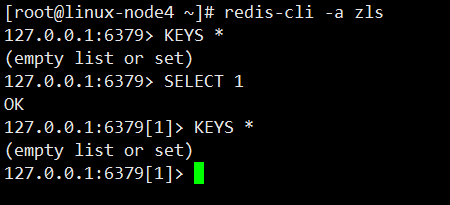
在ES中查看数据
打开浏览器,访问:http://192.168.6.241:9100/

将ES索引添加到Kibana中
打开浏览器,访问:http://192.168.6.243:5601

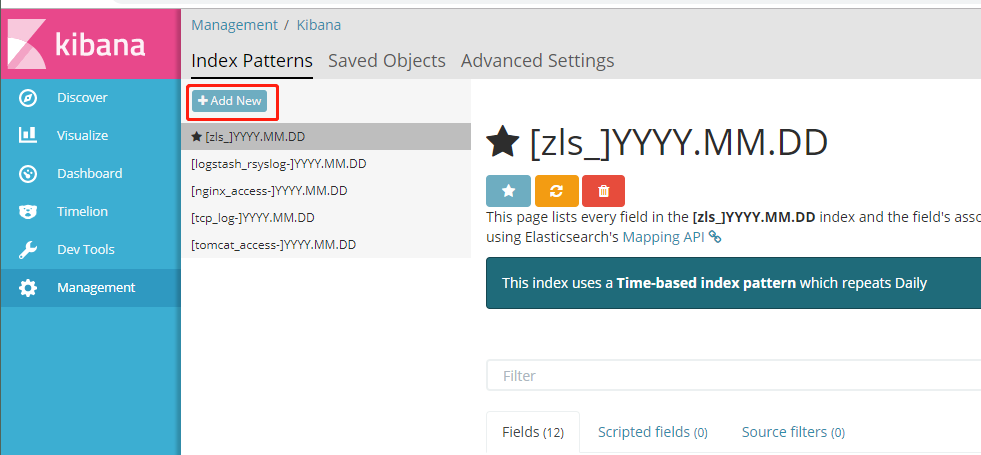
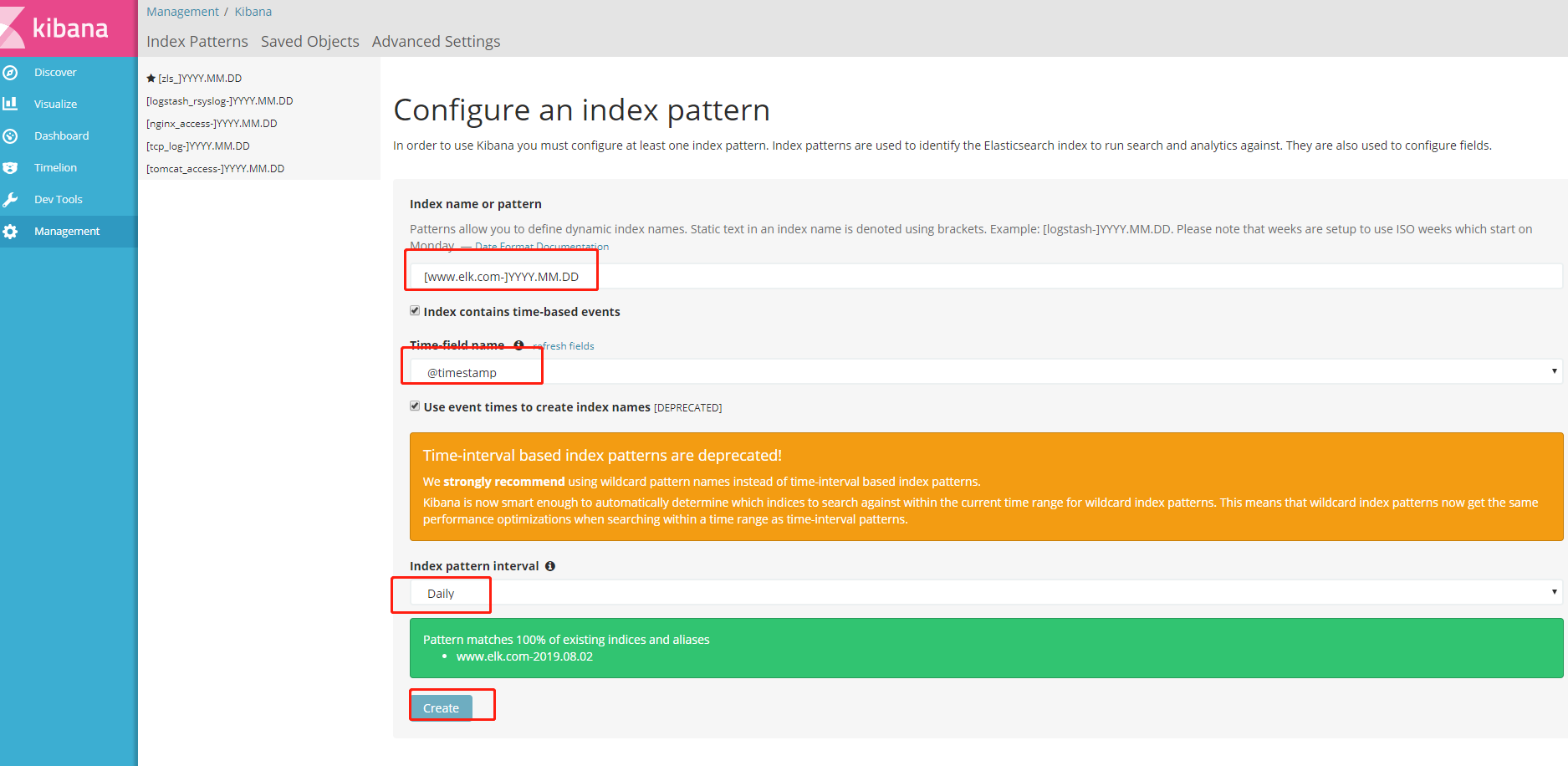
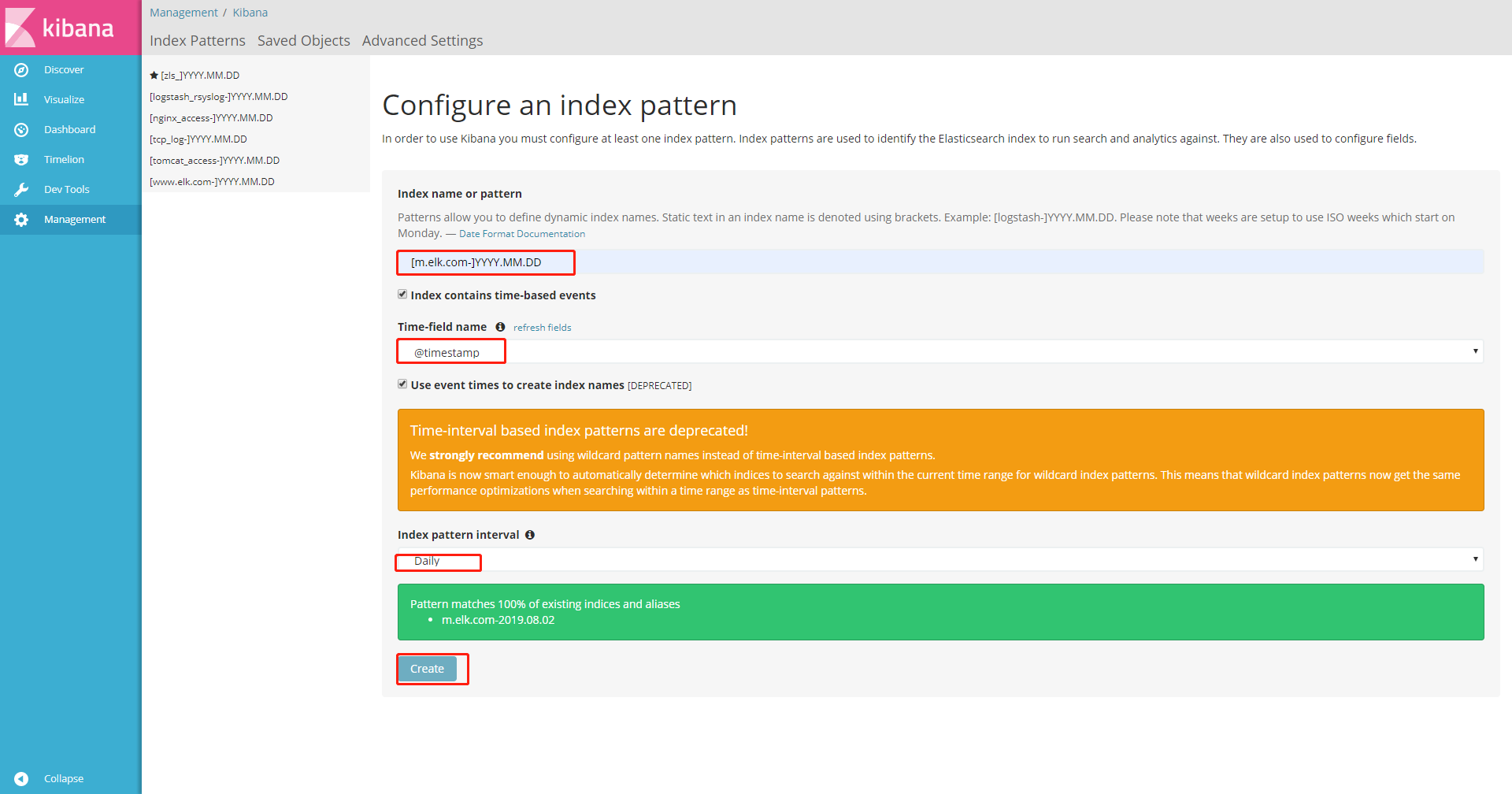
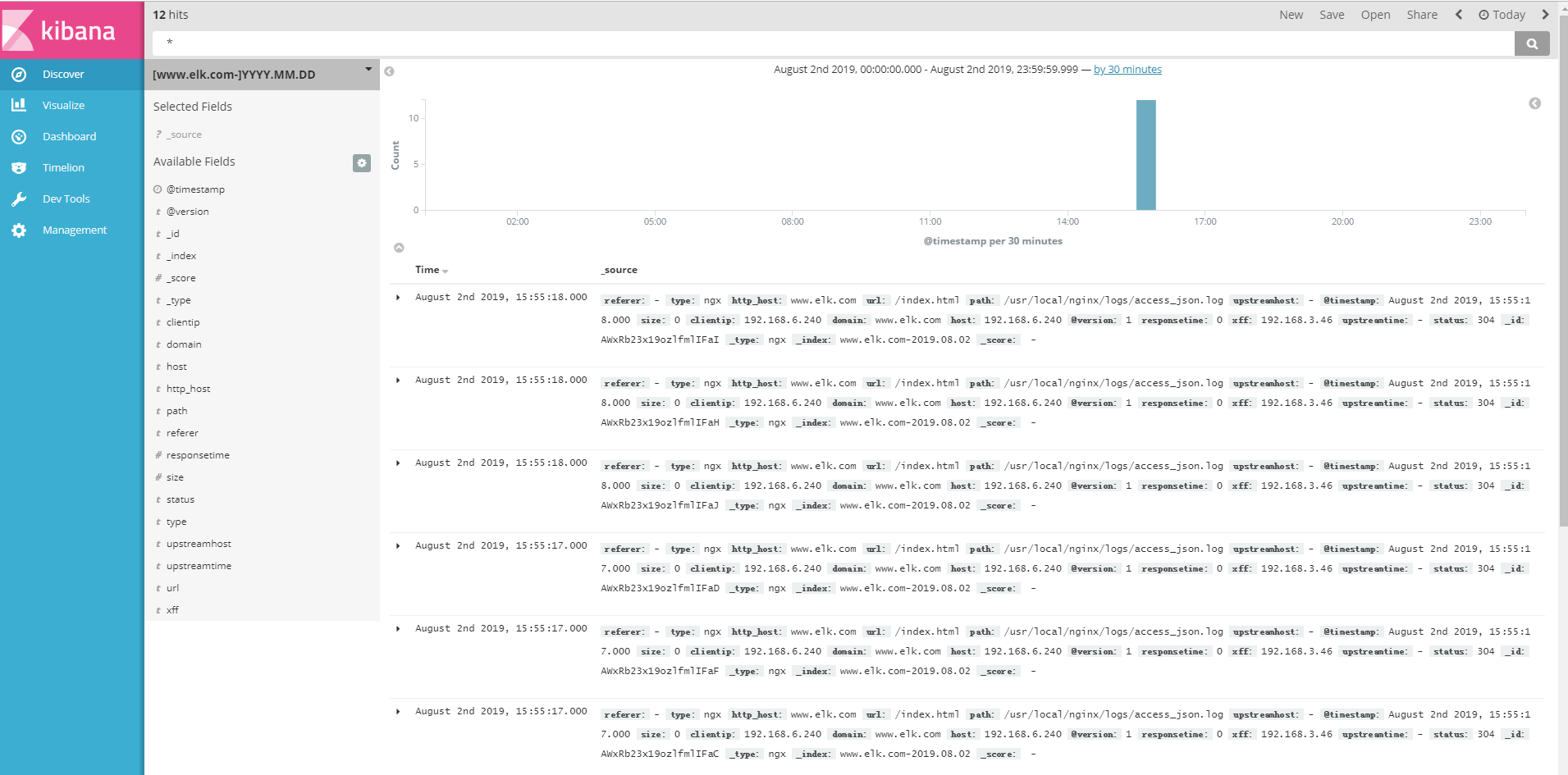
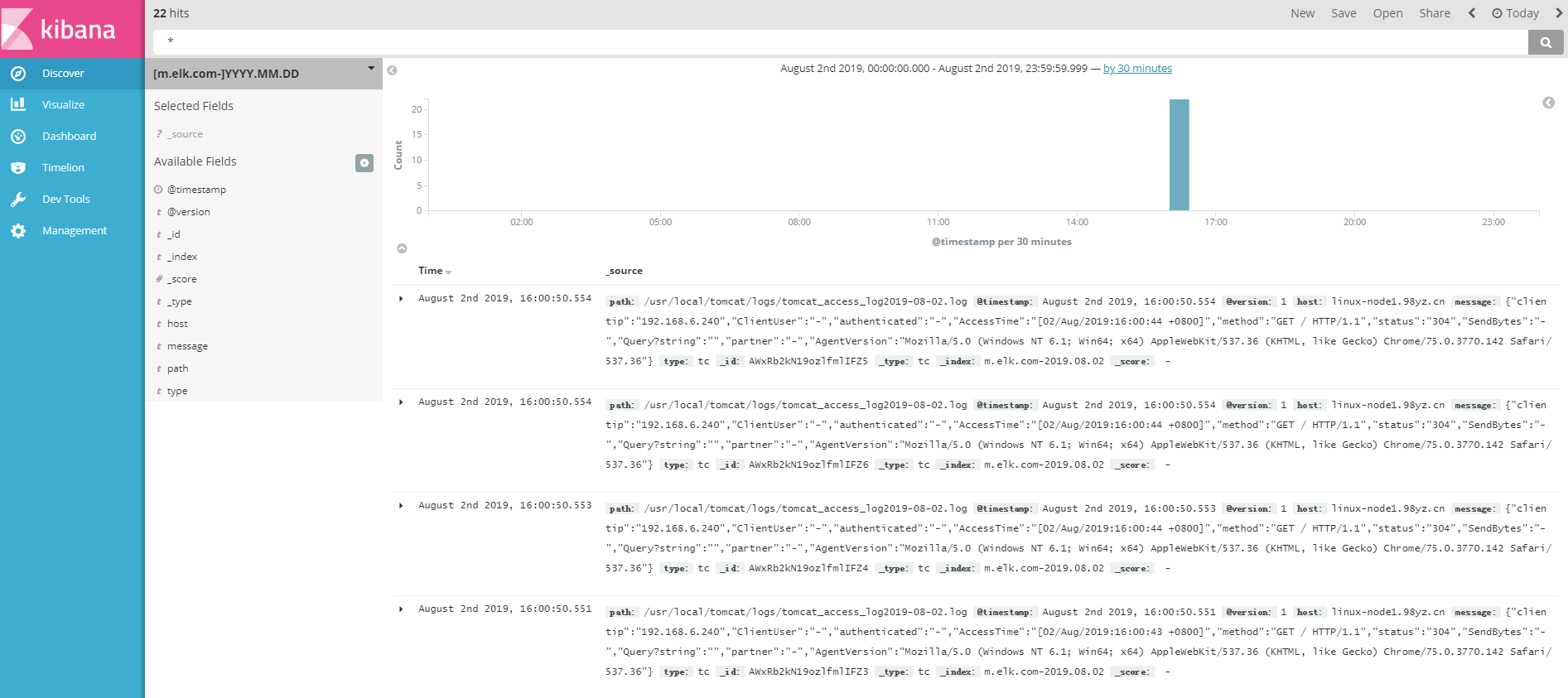
Redis key堆积监控
实际环境当中,可能会出现reids当中堆积了大量的数据而logstash由于种种原因未能及时提取日志,此时会导致redis服务器的内存被大量使用,甚至出现如下内存即将被使用完毕的情景.
[root@linux-node4 ~]# free -m
total used free shared buff/cache available
Mem: 3790 3142 432 2 215 406
Swap: 1023 630 393[root@linux-node4 ~]# vim redis_keylenth.py
#!/usr/bin/env python
#coding:utf-8
#Author Driver_Zeng
import redis
def redis_conn():
pool=redis.ConnectionPool(host="192.168.6.243",port=6379,db=2,password='zls')
conn = redis.Redis(connection_pool=pool)
data = conn.llen('tn')
print(data)
redis_conn()
[root@linux-node4 ~]# python3 redis_keylenth.py
259